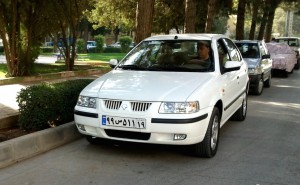
The IKCO Samand is the first "national car" of Iran. At its height, the Iranian auto industry produced 1.6 million vehicles.
The lifting of sanctions against Iran over the weekend opened up a world of new economic possibilities, not just for Iranians, but also the businesses looking to expand into new markets, especially the automotive industry.
Daimler AG made the first move, announcing it signed letters of intent with local partners Iran Khodro Diesel and Mammut Group to arrange a “comprehensive re-entry” into the country where Daimler started doing business in the 1950s, starting with commercial trucks.
“There is a huge demand for commercial vehicles in Iran,” said Daimler Trucks head Wolfgang Bernhard in a statement. “We plan to quickly resume our business activities in the market there.”
Plans include a joint venture for local production of trucks under Daimler’s Mercedes-Benz brand, cooperation on engine production and creation of a sales organization. Plans also include sales of Daimler’s Mitsubishi Fuso brand trucks in cooperation with Mayan, part of the Dubai-based Mammut Group.
(Pact with Iran may open new markets for automakers. For more, Click Here.)
While Daimler, based in Stuttgart, Germany, may be at the vanguard of re-entry into Iran, American auto companies aren’t going to enjoy the same privilege. Because the country met the standard, according to the International Atomic Energy Agency, China, France, Germany, the U.K. and Russia lifted the sanctions tied to the nuclear program.
The U.S. continues to enforce measures against Iran to punish the country for involvement in terrorism and missile development, and the restrictions tied to the nuclear program can be reimposed if the country violates the agreement, according to Bloomberg.
Iranian banks can buy and sell dollars, but they still don’t have access to the American banking system, a vital cog in the global commerce machine.
Additionally, while Iran is able to sell as much oil as it would like globally, the market is already oversupplied so adding its reserves to the equation is likely to only drive prices down even more, limiting the amount of revenue flowing back into the Iranian economy.
(Click Here to see more about GM and Honda’s plans for a joint fuel plant project.)
Still, the potential of the Iranian market – and the $100 billion freed up – is tough to ignore.
“Iran is potentially quite a good market (for vehicles) of over 1 million units annually,” Henner Lehne, senior director of global light vehicle forecasting at IHS Automotive, told TheDetroitBureau previously. “It’s quite an interesting place to be.”
Iran’s indigenous automotive industry was building as many as many as 1.6 million vehicles annually before sanctions slowed the country’s economy. Now that they’ve been lifted, American automakers could end up with the short end of the stick.
During the years, a long list of European and Asian car companies have done business with Iran’s homegrown carmakers, among them Peugeot, Citroen and Renault of France, Volkswagen, BMW and Mercedes-Benz of Germany as well as Nissan and Toyota of Japan, Proton of Malayasia and Chery of China and Hyundai of South Korea.
(To see more about the automakers thriving in a slow Chinese economy, Click Here.)
Another factor impacting most automakers looking to make inroads is that most cars in Iran are fueled by compressed natural gas. U.S. automakers are expanding the number of CNG-powered vehicles they produce, such as Ford F-150, Chevrolet Impala and Silverado and Ram 2500, the number is small and it’s pricey so automakers in the U.S. and Europe aren’t necessarily ready to charge into the country new product offerings.
